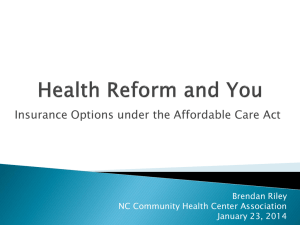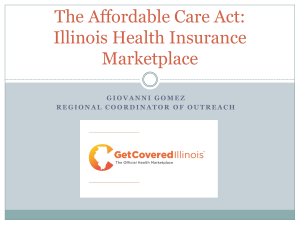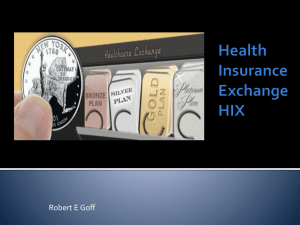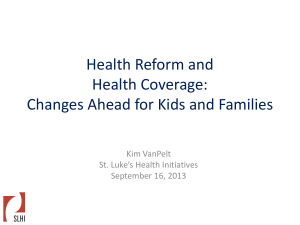to the slides.
advertisement
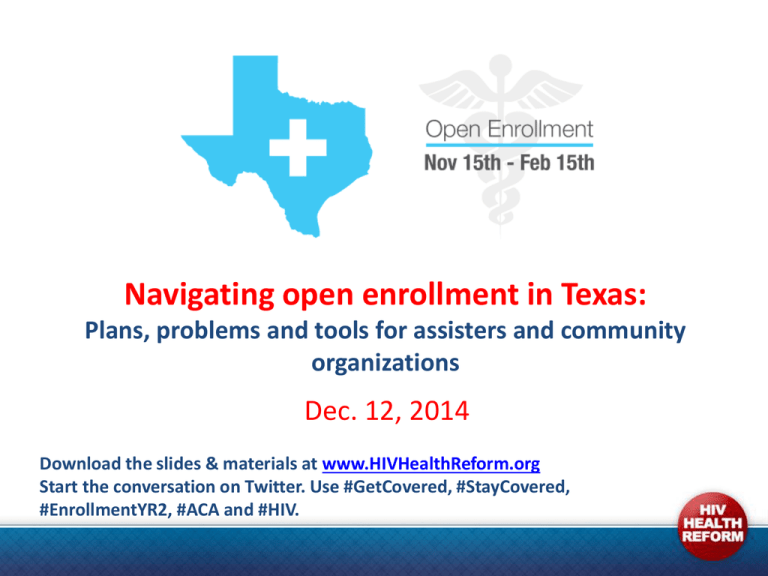
Navigating open enrollment in Texas: Plans, problems and tools for assisters and community organizations Dec. 12, 2014 Download the slides & materials at www.HIVHealthReform.org Start the conversation on Twitter. Use #GetCovered, #StayCovered, #EnrollmentYR2, #ACA and #HIV. Use the Question feature to ask questions during the webinar • All attendees are in listenonly mode • Everyone can ask questions at any time using the questions feature • During Q & A breaks, the moderators will read questions that have been submitted • If you are having audio or webinar trouble, go to HIVHealthReform.org/webin ars for troubleshooting help Can’t hear the audio? Use your telephone! • Click on the “audio” tab • Dial the telephone number, access code, and PIN you see on your computer Download the slides! Go to http://www.HIVHealthReform.org to download the slides, which are featured in the home page slider. Webinars & recordings will be archived at www.HIVHealthReform.org Follow us on social media! Start the conversation on Twitter. Use #GetCovered, #StayCovered, #EnrollmentYR2, #ACA and #HIV. Twitter: @HIVHealthReform Facebook: HIVHealthReform.org Check out HIVHealthReform.org AND DON’T FORGET TO SPEAK UP! • With support from the M·A·C AIDS Fund, a team of national and state partners has established “SPEAK UP” to monitor, assess and document ACA implementation success and barriers to HIV care • Through SPEAK UP we see patterns of discrimination emerging that need to be addressed, educate state and federal officials about what’s happening on the ground, advocate for change, and report back to the community • Monitoring and documentation is critical to help inform and shape state and federal policy to ensure the needs of people living with HIV are addressed as the ACA is implemented To SPEAK UP!, visit: http://www.hivhealthreform.org/speakup/ Today’s Agenda 1. Affordable Care Act & Open Enrollment Landscape in Texas - Januari Leo, Director of Public Affairs, Legacy Community Health Services 2. Texas Marketplace Plan Analysis 2015- Carmel Shachar, Staff Attorney, Center for Health Law & Policy Innovation, Harvard Law School 3. Affordable Care Enrollment (ACE) TA Center Molly McAndrew, Policy Manager, AIDS Foundation of Chicago Affordable Care Act & Open Enrollment Landscape in Texas Januari Leo Director of Public Affairs Legacy Community Health Services Texas Marketplace Plan Analysis 2015 Carmel Shachar Staff Attorney Center for Health Law and Policy Innovation Harvard Law School Enrollment Timeline Open Enrollment began November 15, 2014 and runs through February 15, 2015 Enroll by December 15, 2014 to get coverage by January 1, 2015 Assessment Tools: Marketplace Health Plans Template Assessment Tool/Workbook Download from: http://www.hivhealthreform.org/assessment/ Part 1 Understanding Cost-Sharing Structures Insurance Terms: Cost-Sharing Structures •Premium: monthly fee an insurance plan charges for plan membership •Advance Premium Tax Credit (APTC): money that the government pays directly to a health plan (or to the consumer at the end of the tax year) in order to reduce a consumer’s premium ___________________________________________________________________ •Co-pay: a set fee a consumer pays for each provider visit, prescription refill, lab test, or other healthcare service (e.g., $10, $20, or more) •Co-insurance: a percentage of the cost of the healthcare service that the consumer must pay (e.g., 30% of the cost of a provider visit or of a procedure) •Deductible: a set annual amount the consumer must pay before the insurance plan pays for any of the costs of care (e.g., $2,500) •Cost-sharing Subsidy (Reductions): money that the government pays directly to a health plan in order to reduce a consumer’s out-of-pocket costs (silver plans only) 4 Coverage Levels Marketplace Qualified Health Plans Premiums Platinum $$$$ Gold $$$ Silver $$ Bronze $ Cost Sharing $ $$ $$$ $$$$ Marketplace Premium Tax Credits Tax credits are available to those earning 100% - 400% FPL ($11,670-$46,680) • Tax credits reduce the Premium premium cost depending on Premium Limit Income Limit as % how much income you make / Year of Income (sliding scale) • Tax credits can be used at any plan level (bronze, silver, gold, plantinum), but not for catastrophic coverage • NOTE: There is a reconciliation process at the end of the year, so it’s critical for clients to keep the Marketplace updated on any income changes 100-150% FPL 2.01 – 4.02% $234.57$703.70 150-200% FPL 4.02 – 6.34% $703.70$1,479.76 200-250% FPL 6.34 – 8.1% $1,479.76 $2,363.18 250-300% FPL 8.1 – 9.56% $2,363.18 $3,346.956 300-400% FPL 9.56% $3,346.96 $4,462.61 Premium Tax Credit Example • Earns $16,000/year - about 140% FPL • He is expected to pay about 4% of his income for premiums = $640 per year, or about $53 per month. • Let’s say the second-cheapest Silver plan costs $500 per month. • John’s subsidy will be: $500 - $53 = $447 per month. He can get this as a tax refund or have it paid for him each month. John Cost-Sharing Subsidies and Out Of Pocket (OOP) Maximums Cost-Sharing Subsidies: Available for an applicant: (1) whose income is between 100-250% FPL and (2) who chooses a silver plan Includes: 1. Deductible (if any) 2. Co-insurance for in-network services 3. Co-pays for in-network services Does NOT Include: 1. Premium 2. Costs for out-of-network services Income OOP Max 100-150% FPL $2,250 150-200% FPL $2,250 200-250% FPL $5,200 250% and above $6,600 Ryan White (RW) Payer of Last Resort for Individuals Living with HIV/AIDS • Cannot be used – For “any item or service to the extent that payment has been made or can reasonably be expected to be made” by another payer • Can be used – During gaps in other coverage – IF client misses open enrollment, BUT must ensure that client does not miss next enrollment opportunity – For services not covered or partially covered by other insurance. RW in TX • • Income Limit: 200% FPL Other Qualifications: – HIV positive – Texas state resident – Otherwise uninsured or underinsured Part 2 Evaluating Qualified Health Plans (QHP) How to Choose a Qualified Health Plan Pick a Coverage Level Check if providers in network Check drug formularies Check coverage of other healthcare needs Check cost-sharing for healthcare needs The Online Marketplace Find Marketplace plans for TX residents at healthcare.gov Assessing Plans on Online Marketplace Assessing Plans on Online Marketplace • After entering your information, a summary of available plans will appear • To make it easier to find a particular plan, narrow your results by “Health plan categories” (e.g., silver) or by “Insurance companies.” Assessing Plans on Online Marketplace Search results provide basic information, including estimates for: • Monthly premium • Deductible •Out-of-Pocket Maximum In order to fully assess a plan, you will need to review the linked documents, especially: • Summary of Benefits • List of covered drugs Assessing Plans on Online Marketplace Summary of Benefits: Provides a limited summary of plan benefits, including costsharing rules, referral requirements, and exclusions. Assessing Plans on Online Marketplace List of Covered Drugs (“Formulary”): Provides a list of drugs covered by the plan. Also Provides Information Regarding: • Usage Limitations (e.g., prior authorization, quantity limits, etc.) • Tiering MAY NOT BE A COMPLETE LIST! If the document indicates that the formulary is not comprehensive, you may need to contact the insurer for further coverage information Assessing Plans on Online Marketplace Use the information that you find during your assessment to fill out the Plan Comparison Chart Make sure to note any limitations to your research (e.g., full formulary not available) Part 3 Overview of Available Qualified Health Plans Blue Cross Blue Shield • Pros – Covers most HIV medications, including single tablet regimes such as Atripla, Stribild and Complera – Covers most HCV medications, including Sovaldi • Cons – Generally requires 20-30% co-insurance for HIV medications (but better than other insurers) – Most plans have high deductibles (only the Gold plans have deductibles under $3,000) Humana • Pros – Some plans with “flat” formulary structures: Humana Bronze 6300 and Humana Silver 3650 • Cons – Virtually all HIV and HCV drugs are in the specialty tier – Generally 50% co-insurance for these medications – “Flat” plans have very high deductibles ($6,300 for Bronze and $3,650 for Silver) Cigna • Pros – Very few • Cons – Does not cover a significant number of HIV related medications, including Humira, Enebrel, Simponi, Xelianz – Many HCV drugs “not listed” (and likely not covered), including Sovaldi and Olysio – Most other drugs at 40% co-insurance Next Steps • Forthcoming: a fuller analysis of the plans offered in Texas – Will cover more plans – Will analyze in depth the deductibles, premiums, co-payments and coverage for other services and medications • On the ground assistance – Contact Carmel Shachar at cshachar@law.harvard.edu with further questions Affordable Care Enrollment (ACE) TA Center Molly McAndrew Policy Manager AIDS Foundation of Chicago Resources, Tips, and Tools for Enrolling RWHAP Clients in Coverage Eligibility Decision Tree Health Care Plan Selection Worksheet Fact Sheet: Topics to Consider When Helping People Living With HIV to Enroll in Health Care Coverage Common Questions & Suggested Responses for Engaging Clients in Health Coverage (English) Common Questions & Suggested Responses for Engaging Clients in Health Coverage (Spanish) Plain Language Plain Language Quick Quick Reference Reference Guide (English) Guide 41 Plain Language Plain Language Plain Language Quick Quick Reference Quick Reference Reference Guide (Spanish) Guide Guide 42 Special SpecialEnrollment Enrollment Periods PeriodsFact FactSheet Sheet www.targethiv.org/ace Questions? • Ask your questions using the webinar chat feature. • If we don’t get to your question it will be logged and we’ll do our best to follow up! AND DON’T FORGET TO SPEAK UP! • With support from the M·A·C AIDS Fund, a team of national and state partners has established “SPEAK UP” to monitor, assess and document ACA implementation success and barriers to HIV care • Through SPEAK UP we see patterns of discrimination emerging that need to be addressed, educate state and federal officials about what’s happening on the ground, advocate for change, and report back to the community • Monitoring and documentation is critical to help inform and shape state and federal policy to ensure the needs of people living with HIV are addressed as the ACA is implemented To SPEAK UP!, visit: http://www.hivhealthreform.org/speakup/
